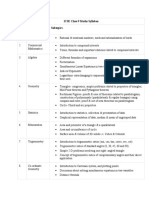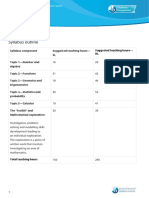0 ratings0% found this document useful (0 votes)
Vertical and Horizontal Articulation Maps
Vertical and Horizontal Articulation Maps
Uploaded by
kolawoleCopyright:
© All Rights Reserved
Available Formats
Download as DOCX, PDF, TXT or read online from Scribd
Download as docx, pdf, or txt
Vertical and Horizontal Articulation Maps
Vertical and Horizontal Articulation Maps
Uploaded by
kolawole0 ratings0% found this document useful (0 votes)
Original Title
Vertical and horizontal Articulation Maps
Copyright
© © All Rights Reserved
Available Formats
DOCX, PDF, TXT or read online from Scribd
Share this document
Did you find this document useful?
Is this content inappropriate?
Copyright:
© All Rights Reserved
Available Formats
Download as DOCX, PDF, TXT or read online from Scribd
Download as docx, pdf, or txt
0 ratings0% found this document useful (0 votes)
Vertical and Horizontal Articulation Maps
Vertical and Horizontal Articulation Maps
Uploaded by
kolawoleCopyright:
© All Rights Reserved
Available Formats
Download as DOCX, PDF, TXT or read online from Scribd
Download as docx, pdf, or txt
You are on page 1/ 3
Vertical Articulation Map
Subject Area: Mathematics
Unit: Rational and Irrational Numbers
Grade Level Progression:
Skill/Concept MYP 1 MYP 2 MYP 3
Understanding Introduction to Simplifying Operations with
Rational fractions and fractions and rational numbers,
Numbers decimals. comparing including
decimals. addition,
subtraction,
multiplication,
and division.
Understanding Basic Recognition and Properties of
Irrational introduction use of irrational irrational
Numbers (e.g., square numbers (e.g., π, numbers,
roots of non- √2). approximation,
perfect squares). and
representation.
Creative Thinking Use of rational Application of Exploring and
numbers in rational numbers creating models
practical contexts to new situations to represent
(e.g., recipes). (e.g., budgeting). irrational
numbers
Critical Thinking Identifying and Analyzing and Drawing
explaining generalizing conclusions
patterns in patterns in about the
rational numbers. irrational properties and
numbers. behaviors of
irrational
numbers.
Horizontal Articulation Map Template
Grade Level: MYP 3
Subject Areas:
Subject Area Unit/Topic 1: Unit/Topic 2:
Rational and Geometry of
Irrational Numbers Polygons
Mathematics - Properties and - Properties of
operations of polygons
rational and (triangles,
irrational numbers. quadrilaterals,
- Applications in etc.).
problem-solving. - Angle
- Creative and calculations and
critical thinking geometric
tasks related to proofs.
number theory. - Application of
theorems (e.g.,
interior and
exterior angles)
Science - Irrational numbers - Geometric
in measurements shapes and their
(e.g., π in circular properties in
measurements). physical
- Rational numbers in structures.
data analysis and - Use of polygons
experiments. in scientific
- Precision and models and
accuracy in scientific diagrams.
data. - Analysis of
polygonal shapes
in nature (e.g.,
crystal structures).
Design - Using rational and - Designing
irrational numbers in geometric shapes
designing patterns and models.
and structures. - Applying
- Applying geometric
mathematical principles in
concepts to practical product design.
design problems. - Using polygons in
creating blueprints
and layouts.
Technology - Use of software to - Computer-aided
explore and visualize design (CAD) and
rational and irrational geometric
numbers. modeling.
- Applications of - Visualization of
geometric principles geometric
in technological tools. concepts using
technology.
- Technological
applications of
polygons in
engineering.
Interdisciplinary Connections:
Connection Mathematics Science Design Technology
Connection 1 - Applying - Using - Creating - Utilizing
properties of irrational designs and software to
rational and numbers in patterns that model and
irrational scientific incorporate analyze
numbers to calculations and rational and geometric
solve real-world measurements. irrational shapes and
problems. numbers. numbers
Connection 2 - Applying - Understanding Designing - Implementing
geometric the role of polygonal geometric
principles to polygons in structures and algorithms in
analyze scientific solving design technology and
properties of structures and problems with product design
polygons in natural geometric
number theory phenomena. concepts.
problems.
Summary
Mathematics focuses on both theoretical aspects and practical applications of rational
and irrational numbers and polygons.
Science explores the use of these mathematical concepts in real-world and
experimental contexts.
Design integrates mathematical principles into practical and creative projects.
Technology uses tools and software to apply and visualize mathematical and
geometric concepts.
You might also like
- IB Math Applications Syllabus Sample Problems PDFNo ratings yetIB Math Applications Syllabus Sample Problems PDF267 pages
- Wendell F. Smith - Experimental Design For Formulation-Society For Industrial and Applied Mathematics - American Statistical Association (2005) PDF100% (3)Wendell F. Smith - Experimental Design For Formulation-Society For Industrial and Applied Mathematics - American Statistical Association (2005) PDF388 pages
- Application and Interpretation (HL and SL) SyllabusNo ratings yetApplication and Interpretation (HL and SL) Syllabus9 pages
- ICSE Class 9 Maths Syllabus Sl. No. Chapter Name SubtopicsNo ratings yetICSE Class 9 Maths Syllabus Sl. No. Chapter Name Subtopics2 pages
- Math-Scope and Sequence-New Form - Career ProgramsNo ratings yetMath-Scope and Sequence-New Form - Career Programs18 pages
- Analytical Methods For Quantity SurveyorNo ratings yetAnalytical Methods For Quantity Surveyor23 pages
- Grade 8 - Capurcos_pajarillo (Comparing K-12 Curriculum and Matatag Curriculum)No ratings yetGrade 8 - Capurcos_pajarillo (Comparing K-12 Curriculum and Matatag Curriculum)6 pages
- 2021 Curriculum Handbook Mathematics (Junior)No ratings yet2021 Curriculum Handbook Mathematics (Junior)12 pages
- Formato de Planificacion Semestral - PrecalculusNo ratings yetFormato de Planificacion Semestral - Precalculus6 pages
- 2024 Subject Guidelines For Term 4 Curriculum Test100% (1)2024 Subject Guidelines For Term 4 Curriculum Test38 pages
- G10 STD - Final Exam Notification - Sem 2 2023No ratings yetG10 STD - Final Exam Notification - Sem 2 20233 pages
- 2021 - Pemodelan Matematika Dan Beberapa Aplikasinya - UNPNo ratings yet2021 - Pemodelan Matematika Dan Beberapa Aplikasinya - UNP20 pages
- Instruction Division SECOND SEMESTER 2017-2018 Course Handout - Part IINo ratings yetInstruction Division SECOND SEMESTER 2017-2018 Course Handout - Part II7 pages
- Westwood International School Mathematics DepartmentNo ratings yetWestwood International School Mathematics Department14 pages
- EGE 7 - Comparative Study of Curriculum - JOYCE MENDEZ - III-BEED-BNo ratings yetEGE 7 - Comparative Study of Curriculum - JOYCE MENDEZ - III-BEED-B5 pages
- What Is Less Than Nothing - Unit Planner 2022-2023No ratings yetWhat Is Less Than Nothing - Unit Planner 2022-20235 pages
- Course Code: Course Title TPC Version No. Course Pre-Requisites/ Co-Requisites/ Anti-Requisites (If Any)100% (1)Course Code: Course Title TPC Version No. Course Pre-Requisites/ Co-Requisites/ Anti-Requisites (If Any)3 pages
- MH CET Law Maths Practice Questions PDF_1736365203986No ratings yetMH CET Law Maths Practice Questions PDF_173636520398672 pages
- G10 Unit 1 Ext - STD Periodic Phenomena Unit PlannerNo ratings yetG10 Unit 1 Ext - STD Periodic Phenomena Unit Planner4 pages
- Geometric Hashing: Efficient Algorithms for Image Recognition and MatchingFrom EverandGeometric Hashing: Efficient Algorithms for Image Recognition and MatchingNo ratings yet
- Here Is A Comprehensive Plan For An InquiryNo ratings yetHere Is A Comprehensive Plan For An Inquiry4 pages
- Electricity Class 10 Questions and AnswersNo ratings yetElectricity Class 10 Questions and Answers1 page
- Grade 7: MS Exemplar Unit Mathematics Grade 7 Edition 1No ratings yetGrade 7: MS Exemplar Unit Mathematics Grade 7 Edition 111 pages
- Sample Jefferson IB MYP Report Card With Comments100% (2)Sample Jefferson IB MYP Report Card With Comments4 pages
- Form Representation, Justification Fairness and Development: Accessing Equal OpportunitiesNo ratings yetForm Representation, Justification Fairness and Development: Accessing Equal Opportunities6 pages
- Mathematics: I. Course Description and AimsNo ratings yetMathematics: I. Course Description and Aims4 pages
- Civil Engineering RCC: THE GATE COACH All Rights Reserved 28, Jia Sarai N. Delhi 1 - 26528213, - 9998No ratings yetCivil Engineering RCC: THE GATE COACH All Rights Reserved 28, Jia Sarai N. Delhi 1 - 26528213, - 999811 pages
- Dynamic Analysis of Geometrically Nonlinear Truss Structures SNo ratings yetDynamic Analysis of Geometrically Nonlinear Truss Structures S7 pages
- Digital Processing Tools: 2.1 Spatial TransformationsNo ratings yetDigital Processing Tools: 2.1 Spatial Transformations5 pages
- Measurement: Arslan Ahmed Amin, Khalid Mahmood HasanNo ratings yetMeasurement: Arslan Ahmed Amin, Khalid Mahmood Hasan11 pages
- Fast Structural Interpretation With Structure-Oriented FilteringNo ratings yetFast Structural Interpretation With Structure-Oriented Filtering8 pages
- Creative Forces of Self Organization CompactNo ratings yetCreative Forces of Self Organization Compact28 pages










































































































